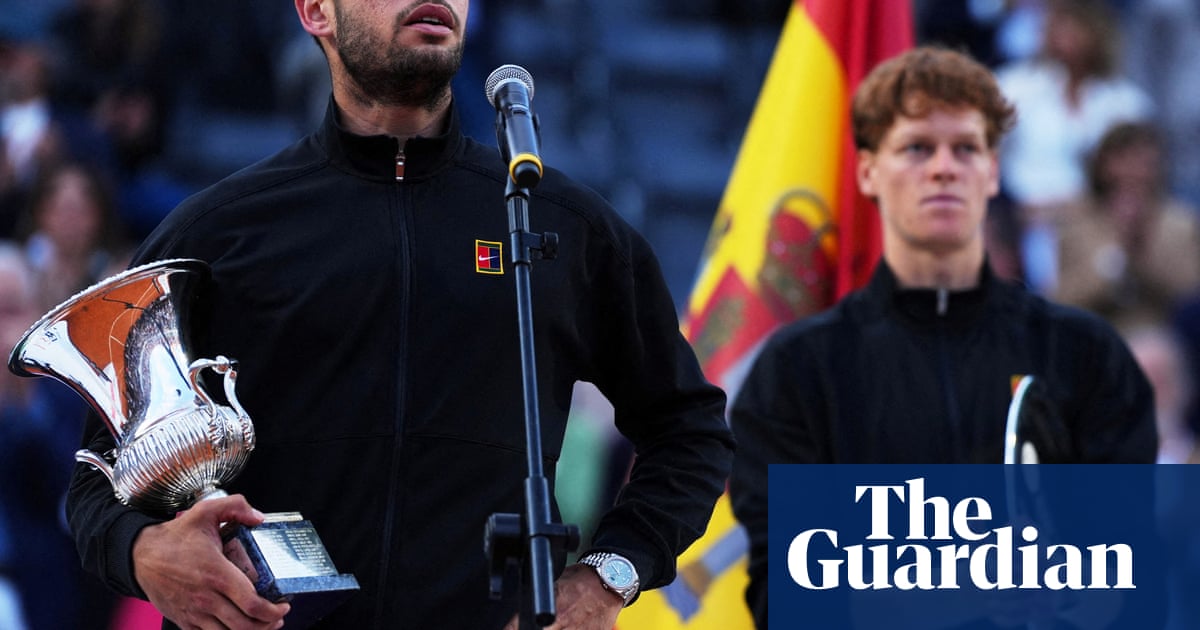Alittle over an hour after reinforcing his supremacy on red clay with his first title at the Italian Open,Carlos Alcarazended his time in Rome with an ominous, pointed parting shot from the bowels of the Campo Centrale. “He’s going to be dangerous,” said Alcaraz. “He’s going to be a really dangerous player in Paris.”
Alcaraz was speaking, of course, about his greatest rival, Jannik Sinner, whom he had justdefeated in two fascinating setsin the final. Over the next fortnight in Paris, one of the pressing questions surrounding the tournament will be whether Alcaraz and Sinner, the top two seeds, can consolidate those performances by meeting in a grand slam final for the first time.
Historically, the absence of a top player is good news for their rival, but few competitors were as happy to see Sinner back in action as Alcaraz. Since the No 1’s three-month doping ban was announced, the Spaniard has struggled with the additional attention and scrutiny, with so many people expecting him to win every tournament he entered. He said that the pressure, at times, “killed” him.
From an excruciating March, when Alcaraz was handcuffed by anxiety before matches, he found his path again by focusing on himself and the joy he plays with on court. His performances in Rome were notable for the maturity he demonstrated throughout. Instead of his usual turbulent level, demonstrating both his genius and inconsistency, Alcaraz simply produced what each moment demanded of him. He was spectacular when necessary, but he also ground down his opponents by merely being solid in the decisive moments.
“During the matches in some moments I was just feeling totally different,” said Alcaraz. “Before I was totally nervous, couldn’t handle the nerves as better as I’m doing right now. I was focused in other things that were important, about the results, about I have to win, I have to make results. Right now I’m focusing in totally a different way, in different things, which is just being happy, being proud about the moments that I’m living. I think that’s the right path. So I’m just feeling great, feeling great right now.”
As Alcaraz clinched his second Masters 1000 title of the clay-court season, ensuring he will be the player to watch as he attempts to defend hisFrench Opentitle, Rome was an even more significant occasion for the defeated finalist. In his first tournament back after his ban, Sinner blazed a path to the final in front of a deafening home crowd, immediately re-establishing himself as one of the top contenders in every tournament in the world and providing himself with an excellent base to build upon. On Friday, Sinner discussed both his satisfaction at his progress in Rome and the path ahead as he tries at Roland Garros to win his first grand slam title away from hard courts.
“There are no miracles, no? I need some time,” said Sinner. “Matches are different than practice sessions. But we are working hard, trying to reach the physical level I would like to, and how I would like to feel on court. Of course it pops into, you know, also the tennis part where it’s just a little bit different. But best-of-five is going to be a great test for me, trying to understand where I am. Let’s see how my body will respond here.”
It is unclear who will be there in the latter rounds to derail them. The tour was a turbulent, inconsistent place in Sinner’s absence and Alexander Zverev, Taylor Fritz and Daniil Medvedev have all struggled. Others,such as Jack Draperand Lorenzo Musetti, have embedded themselves inside the top eight. Actually contending for the title, however, would mark a significant step forward for both.
Sign up toThe Recap
The best of our sports journalism from the past seven days and a heads-up on the weekend’s action
after newsletter promotion
In the women’s draw, Iga Swiatek has spent the past five years establishing one of the most dominant eras among female players at Roland Garros in history, winning the previous three editions and four of the past five. No woman in the open era has won four consecutive French Open titles.
At the same time that Swiatek is trying to break new ground among female players in the modern era of the sport, she is in her biggest crisis since becoming No 1 three years ago. After spending recent years sweeping up titles on both hard courts and clay, the Pole has not won a title at any level since the last edition of the French Open. Her confidence has particularly been blunted by her shock defeat in the semi-finals of the Olympic Games at Roland Garros last August and her own doping case, which led her to accept a one-month ban after taking widely available melatonin medication that had been contaminated by the banned substance trimetazidine. After losing 6-1, 6-1 to Coco Gauff in her Madrid title defence, she was defeated in the third round of the Italian Open by Danielle Collins.
AsSwiatek has struggled, her rivals have only improved. Gauff has made significant ground in a match-up that once looked hopeless for her, beating Swiatek twice this year, and Aryna Sabalenka has further solidified her status as the best player in the world by finding even greater consistency on a day to day basis. Mirra Andreeva has continued to progress, establishing herself as one of the top players at just 18 years old, while Jasmine Paolini and Zheng Qinwen showedlast week in Romethat their breakout 2024 seasons were no flukes. The stakes have never been higher for Swiatek in the tournament she has made her home, but it is often in these perilous moments that the greatest players demonstrate their worth.
